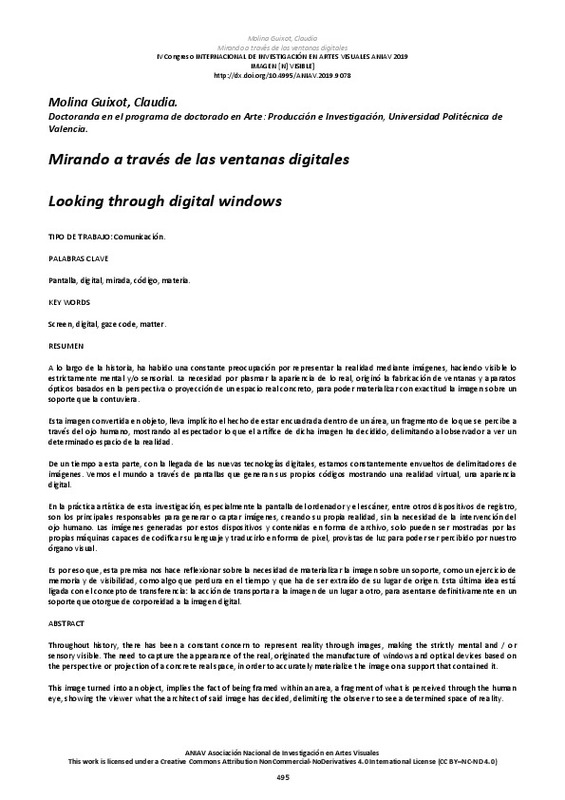|
Resumen:
|
[ES] A lo largo de la historia, ha habido una constante preocupación por representar la realidad mediante imágenes, haciendo visible lo
estrictamente mental y/o sensorial. La necesidad por plasmar la apariencia de lo real, ...[+]
[ES] A lo largo de la historia, ha habido una constante preocupación por representar la realidad mediante imágenes, haciendo visible lo
estrictamente mental y/o sensorial. La necesidad por plasmar la apariencia de lo real, originó la fabricación de ventanas y aparatos
ópticos basados en la perspectiva o proyección de un espacio real concreto, para poder materializar con exactitud la imagen sobre un
soporte que la contuviera.
Esta imagen convertida en objeto, lleva implícito el hecho de estar encuadrada dentro de un área, un fragmento de lo que se percibe a
través del ojo humano, mostrando al espectador lo que el artífice de dicha imagen ha decidido, delimitando al observador a ver un
determinado espacio de la realidad.
De un tiempo a esta parte, con la llegada de las nuevas tecnologías digitales, estamos constantemente envueltos de delimitadores de
imágenes. Vemos el mundo a través de pantallas que generan sus propios códigos mostrando una realidad virtual, una apariencia
digital.
En la práctica artística de esta investigación, especialmente la pantalla del ordenador y el escáner, entre otros dispositivos de registro,
son los principales responsables para generar o captar imágenes, creando su propia realidad, sin la necesidad de la intervención del
ojo humano. Las imágenes generadas por estos dispositivos y contenidas en forma de archivo, solo pueden ser mostradas por las
propias máquinas capaces de codificar su lenguaje y traducirlo en forma de pixel, provistas de luz para poder ser percibido por nuestro
órgano visual.
Es por eso que, esta premisa nos hace reflexionar sobre la necesidad de materializar la imagen sobre un soporte, como un ejercicio de
memoria y de visibilidad, como algo que perdura en el tiempo y que ha de ser extraído de su lugar de origen. Esta última idea está
ligada con el concepto de transferencia: la acción de transportar a la imagen de un lugar a otro, para asentarse definitivamente en un
soporte que otorgue de corporeidad a la imagen digital.
[-]
[EN] Throughout history, there has been a constant concern to represent reality through images, making the strictly mental and / or
sensory visible. The need to capture the appearance of the real, originated the manufacture ...[+]
[EN] Throughout history, there has been a constant concern to represent reality through images, making the strictly mental and / or
sensory visible. The need to capture the appearance of the real, originated the manufacture of windows and optical devices based on
the perspective or projection of a concrete real space, in order to accurately materialize the image on a support that contained it.
This image turned into an object, implies the fact of being framed within an area, a fragment of what is perceived through the human
eye, showing the viewer what the architect of said image has decided, delimiting the observer to see a determined space of reality.
For a while now, with the arrival of new digital technologies, we are constantly surrounded by image delimiters. We see the world
through screens that generate their own codes showing a virtual reality, a digital appearance.
In the artistic practice of this research, especially the computer screen and the scanner, among other recording devices, are the main
responsible for generating or capturing images, creating their own reality, without the need for the intervention of the human eye.
The images generated by these devices and contained in file form, can only be shown by the machines themselves capable of coding
their language and translate it into a pixel, provided with light to be perceived by our visual organ.
That is why, this premise makes us reflect on the need to materialize the image on a support, as an exercise of memory and visibility,
as something that lasts over time and that has to be extracted from its place of origin. This last idea is linked to the concept of
transfer: the action of transporting the image from one place to another, to settle definitively in a support that gives corporeality to
the digital image.
[-]
|








